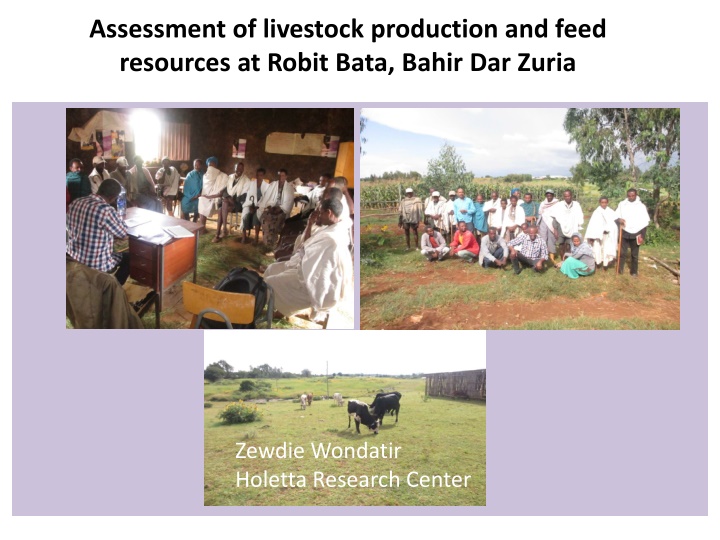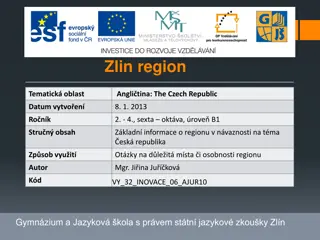
Livestock Production and Feed Resources Assessment at Robit Bata, Bahir Dar Zuria
This assessment focuses on livestock production and feed availability in Robit Bata, a village near Bahir Dar. It highlights farming systems, major crops, feed resources, constraints, and potential intervention strategies identified through the study.
Download Presentation

Please find below an Image/Link to download the presentation.
The content on the website is provided AS IS for your information and personal use only. It may not be sold, licensed, or shared on other websites without obtaining consent from the author. If you encounter any issues during the download, it is possible that the publisher has removed the file from their server.
You are allowed to download the files provided on this website for personal or commercial use, subject to the condition that they are used lawfully. All files are the property of their respective owners.
The content on the website is provided AS IS for your information and personal use only. It may not be sold, licensed, or shared on other websites without obtaining consent from the author.
E N D
Presentation Transcript
Assessment of livestock production and feed resources at Robit Bata, Bahir Dar Zuria Zewdie Wondatir Holetta Research Center
Background Robit Bata village Located approximately 20 kms from Bahir Dar town Mixed farming is the major farming system in the area Major crops grown in the area include maize, finger millet, tef, rice and chick pea Crop residues and collected fodder are the major feed resource in the dry and wet seasons, respectively
Objectives To assess rapidly the prevailing farming and livestock production system, feed resources availability and livestock production constraints To identify potential intervention strategies for the development of livestock feed resources.
Methodology Three sub-villages were selected based from the kebele on their representation to ILSSI project The sub-villages selected were Deri Gedel, Jimma Midir and Terara Gichamintola A total of 45 farmers (15 from each sub-village) were selected based on wealth category (small, medium and large landholdings) for focused group discussion and quantitative data collection Female households participation was encouraged FEAST software was used to analyse quantitative data FEAST macro excel program(www.ilri.org/feast)
Result and Discussions General overview of the study village Mixed crop livestock production Water is not easily available due to hard rock pan Number of households in Deri Gedel, Jimma Midir and Terara Gichamintola were 400, 876 and 707, respectively
Result and discussions Landholding.pptx Crop production.pptx Livestock production.pptx Household income sources.pptx Major livestock feed resources Purchased feeds.pptx improved forages.pptx Contribution available feed resources to the total dry matter.pptx Contribution available feed resources to the total Metabolizable energy.pptx Contribution available feed resources to the total Crude protein.pptx Feed availability and rainfall pattern across different months of a year.pptx
Major Livestock Production constraints Table 1. Deri Gedel sub-village Problems listed Livestock feed shortage Suggested solutions Allocate land for improved forages at backyards and multiply it Reduce herd size Training on how to utilize locally available feed resources Problems 1 Lack of improved cattle breeds Artificial Insemination services provision Improved bull services Link with research centers for improve dairy cattle Training on livestock health, housing and feeding 2 Knowledge gap on livestock management 3 Table 2. Jimma Midir sub-village Problems 1 Problems listed Limited know-how on animal management and husbandry Suggested solutions Training on improved animal management and husbandry system Experience sharing with model farmers Establish improved forages at backyard level Training on how to mix simple ration, feed treatment and processing Make animal health clinic and services available at kebele level Assign AI technician at kebele level Provide improved bull service Train AI technician from the community themselves 2 Livestock feed shortage 3 Lack of public animal health services Lack of improved cattle breeds 4
Table 3. Terara Gichamintola sub-village Problems Problems listed Solutions suggested by farmers 1 Poor genetic makeup of indigenous cattle breeds/lack of genetically improved animals Knowledge gap on improved livestock husbandry and management Lack of public animal health services Promote AI services and improve availability Offer improved bull services Cross selected local cattle with improved breeds 2 Experience sharing from best model farmers Training on improved livestock and husbandry practices 3 Assign public animal health workers and services at the kebele level Awareness on disease prevention Allocate land and establish improved forages at the backyard level Reduce herd size Improve feed storage 4 Livestock feed shortage
Conclusion and suggestions for future intervention Provide farmers with training on appropriate utilization of available feed resources and development and use of improved forages. Link improved forage development with the existing irrigation practice Strengthening the existing livestock extension system particularly management, husbandry, feeding, breeding and animal health in the village Improve the existing indigenous cattle genetic potential through selection and crossbreeding

